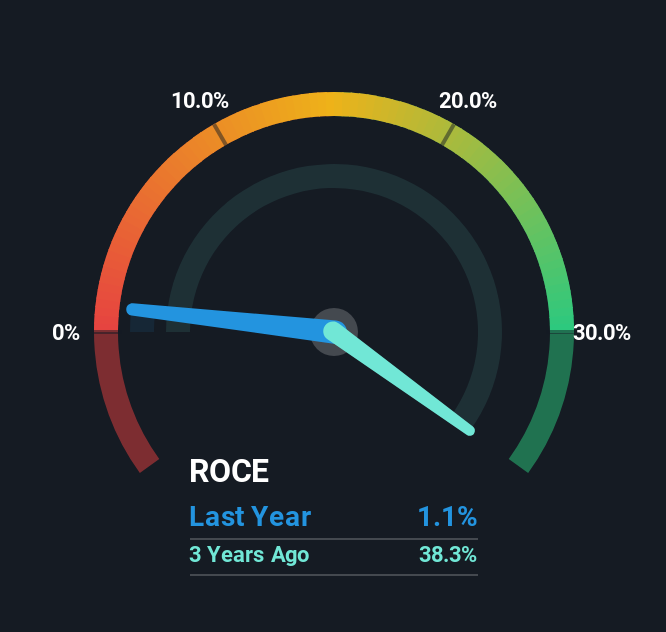- United States
- /
- Metals and Mining
- /
- NYSE:RYI
Ryerson Holding's (NYSE:RYI) Returns On Capital Tell Us There Is Reason To Feel Uneasy
When we're researching a company, it's sometimes hard to find the warning signs, but there are some financial metrics that can help spot trouble early. More often than not, we'll see a declining return on capital employed (ROCE) and a declining amount of capital employed. This indicates to us that the business is not only shrinking the size of its net assets, but its returns are falling as well. On that note, looking into Ryerson Holding (NYSE:RYI), we weren't too upbeat about how things were going.
What Is Return On Capital Employed (ROCE)?
If you haven't worked with ROCE before, it measures the 'return' (pre-tax profit) a company generates from capital employed in its business. The formula for this calculation on Ryerson Holding is:
Return on Capital Employed = Earnings Before Interest and Tax (EBIT) ÷ (Total Assets - Current Liabilities)
0.011 = US$20m ÷ (US$2.5b - US$647m) (Based on the trailing twelve months to March 2025).
Thus, Ryerson Holding has an ROCE of 1.1%. In absolute terms, that's a low return and it also under-performs the Metals and Mining industry average of 9.4%.
See our latest analysis for Ryerson Holding

In the above chart we have measured Ryerson Holding's prior ROCE against its prior performance, but the future is arguably more important. If you'd like to see what analysts are forecasting going forward, you should check out our free analyst report for Ryerson Holding .
How Are Returns Trending?
In terms of Ryerson Holding's historical ROCE movements, the trend doesn't inspire confidence. To be more specific, the ROCE was 9.9% five years ago, but since then it has dropped noticeably. And on the capital employed front, the business is utilizing roughly the same amount of capital as it was back then. This combination can be indicative of a mature business that still has areas to deploy capital, but the returns received aren't as high due potentially to new competition or smaller margins. If these trends continue, we wouldn't expect Ryerson Holding to turn into a multi-bagger.
In Conclusion...
In summary, it's unfortunate that Ryerson Holding is generating lower returns from the same amount of capital. Yet despite these poor fundamentals, the stock has gained a huge 340% over the last five years, so investors appear very optimistic. Regardless, we don't feel too comfortable with the fundamentals so we'd be steering clear of this stock for now.
If you want to know some of the risks facing Ryerson Holding we've found 2 warning signs (1 is potentially serious!) that you should be aware of before investing here.
While Ryerson Holding may not currently earn the highest returns, we've compiled a list of companies that currently earn more than 25% return on equity. Check out this free list here.
New: AI Stock Screener & Alerts
Our new AI Stock Screener scans the market every day to uncover opportunities.
• Dividend Powerhouses (3%+ Yield)
• Undervalued Small Caps with Insider Buying
• High growth Tech and AI Companies
Or build your own from over 50 metrics.
Have feedback on this article? Concerned about the content? Get in touch with us directly. Alternatively, email editorial-team (at) simplywallst.com.
This article by Simply Wall St is general in nature. We provide commentary based on historical data and analyst forecasts only using an unbiased methodology and our articles are not intended to be financial advice. It does not constitute a recommendation to buy or sell any stock, and does not take account of your objectives, or your financial situation. We aim to bring you long-term focused analysis driven by fundamental data. Note that our analysis may not factor in the latest price-sensitive company announcements or qualitative material. Simply Wall St has no position in any stocks mentioned.
About NYSE:RYI
Ryerson Holding
Processes and distributes industrial metals in the United States and internationally.
Good value with adequate balance sheet.
Similar Companies
Market Insights
Community Narratives





